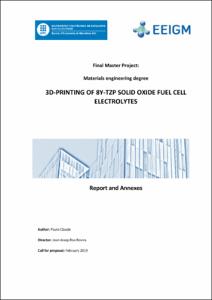Mostra el registre d'ítem simple
3D-printing of 8Y-TZP solid oxide fuel cell electrolytes
| dc.contributor | Roa Rovira, Joan Josep |
| dc.contributor.author | Claude, Paulo |
| dc.date.accessioned | 2019-11-08T19:21:46Z |
| dc.date.available | 2019-11-08T19:21:46Z |
| dc.date.issued | 2019-02-15 |
| dc.identifier.uri | http://hdl.handle.net/2117/172010 |
| dc.description.abstract | In this Master's thesis were printed electrolytes for Solid Oxide Fuel Cell (SOFC) in yttria stabilized zirconia by additive manufacturing robocasting method and then characterized from the microstructural and mechanical points of view. In order to enhanced the density of the material with this manufacturing process, it was necessary to determine the optimum composition of the paste, composed of 8Y-TZP powder and hydrogel, and the optimal printing temperature to manufacture the samples. The hydrogel used was made with 25 wt.% of pluronic F-127® and 75 wt.% of distilled water. The optimal composition found was of 67,5 wt.% of ceramic powder and 32,5 wt.% of hydrogel, allowing the obtention of a relative density value close to 100% for the printed material after the realization of a sintering process at a temperature of 1450°C. Diverse injection heads were tested regarding the particle and agglomerate sizes of the ceramic powder, also in order to maximize the density of the final parts. The injection nozzle which showed the best results was made of plastic (smoothflow tapered tip) and with an injection diameter of 580 μm. Once these parameters fixed, two different geometries were printed: cylindric and tubular. Then, two different printing patterns, rectilinear and concentric, were tested in order to obtain the best appearance for the printed samples. The rectilinear one was chosen for the cylindrical geometry while the concentric one was chosen for the tubular geometry. The shrinkage of the material during the sintering process was measured and estimated equal to 57 ± 1.4 % of volume reduction for the optimal composition chosen previously. Were characterized for both geometries, along with samples manufactured by Cold Isostatic Pressing (CIP) (reference), the microstructure (phases composition, external porosity, grain size) as well as the mechanical properties (hardness, fracture toughness, elastic modulus). In a first time, the samples manufactured with AM and CIP were analyzed along with the initial 8Y-TZP powder with X-Ray Diffraction (XRD) in order to see if the manufacturing process could affect the phase composition of the material, which is not the case. With a Field Emission Scanning Electron Microscope (FESEM) were measured the external porosities of the different samples and the grain sizes of the material after the realization of a thermal attack at 1200°C. It was found that the amount of porosity for the samples printed was clearly higher than the one found for samples manufactured with CIP. The average value of grain area found was 3.07 μm2. Concerning the mechanical properties, Vickers indentation allowed the obtention of the average hardness values of 10.9 ± 0.7 GPa (HV10) and 10.9 ± 0.8 GPa (HV5) as well as average fracture toughness values of 2.37 ± 0.73 MPa.m-0.5 (HV10) and 3.63 ± 1.03 MPa.m-0.5 (HV5). On the other hand, the Berkovich nanoindentation realized allowed the obtention of a range of hardness value comprise between 15.7 and 17.0 GPa as well as a range of young modulus comprise between 252 and 276 GPa for the samples manufactured with the optimum composition of materials. |
| dc.language.iso | eng |
| dc.publisher | Universitat Politècnica de Catalunya |
| dc.rights | Attribution-NonCommercial-NoDerivs 3.0 Spain |
| dc.rights.uri | http://creativecommons.org/licenses/by-nc-nd/3.0/es/ |
| dc.subject | Àrees temàtiques de la UPC::Enginyeria dels materials |
| dc.subject.lcsh | Solid oxide fuel cells |
| dc.subject.lcsh | Zirconium |
| dc.subject.lcsh | Three-dimensional printing |
| dc.subject.other | 3D printing |
| dc.subject.other | yttria stabilized zirconia |
| dc.subject.other | SOFC |
| dc.title | 3D-printing of 8Y-TZP solid oxide fuel cell electrolytes |
| dc.type | Master thesis |
| dc.subject.lemac | Piles de combustible d'òxid sòlid |
| dc.subject.lemac | Zirconi |
| dc.subject.lemac | Impressió 3D |
| dc.identifier.slug | PRISMA-139547 |
| dc.rights.access | Open Access |
| dc.date.updated | 2019-10-28T09:38:04Z |
| dc.audience.educationlevel | Màster |
| dc.audience.mediator | Escola d'Enginyeria de Barcelona Est |
| dc.audience.degree | MÀSTER UNIVERSITARI EN CIÈNCIA I ENGINYERIA DE MATERIALS (Pla 2014) |
| dc.contributor.covenantee | Université de Lorraine |


